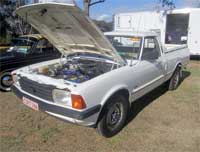Manufacturers need global integration

But these weren't battle tanks built by national weapons manufacturer Armscor to fight communist rebels in Angola and South West Africa, or quell township unrest at home. They bore more familiar names - such as Mercedes-Benz, Toyota, BMW, Ford and Nissan
For many years, SA motor industry policy rewarded vehicle manufacturers for weight. The heavier the percentage of local content, the bigger the cash incentive. So companies built cars and bakkies with the heaviest SA steel and parts they could find.
The resulting vehicles may have looked much the same as their overseas counterparts but, beneath the skin, they were overweight monsters. To be struck at speed by one of these (this was before the days of collapsible bonnets and passenger-protecting shells) was like being hit by a tank. They were virtually unsaleable outside SA.
Of course, it was possible to look beyond SA for lighter, more nimble cars. But this was the sanctions era, when protectionism and self-sufficiency were at their peak. Customs duties totalling as much as 135% made non-SA vehicles unaffordable to all but the very rich.
Familiar names, different species
Though most local motor companies continued to bear the names of their multinational parents, their assembly plants were isolated from global production networks. Disinvestment forced some companies to change their identities altogether. Ford in SA became, variously, Sigma, Amcar and Samcor. General Motors was Delta for some years.

SA motor industry policy has a chequered history. The automotive production development programme (APDP), which came into force this year and is due to run until 2020, is the seventh official phase. Not all of them achieved their objectives, which is why there was overlapping of local content targets:
- Phase one, from 1961-1963, aimed to increase the weight of local content from 15% to 40%. Imported cars faced a 35% ad valorem tax plus additional levies of up to 100%;
- Phase two (1964-1969) was intended to take local content from 45% to 55%;
- Phase three (1971-1976) was to grow local content from 52% to 66%;
- Phase four (1977-1978) was a two-year consolidation period to help the industry adjust to economic difficulties;
- Phase five (1980-1988) had a minimum 66% local content for cars and 50% for light commercial vehicles and minibuses;
- Phase six (1989-1995) was the first programme to measure local content by value rather than weight. It encouraged companies to increase the industry average from 55% to 75%. Local content was defined as the factory price less foreign currency used, but including profit and overheads. Exports were encouraged for the first time, by being included in the local content value. As late as December 1993, imported vehicles were still subject to a 100% import duty, as well as a 15% surcharge on cars and 5% on commercial vehicles. The import duty fell to 80% at the beginning of 1994.
The motor industry development programme (MIDP, 1995-2012) took advantage of SA's release from political and economic isolation. In broad terms, however, it was intended to integrate SA into the global motor industry; reduce tariff protection; increase exports; rationalise the number of vehicle models produced in SA; and encourage modernisation.
The APDP (2013-2020) is supposed to build on the achievements of the MIDP. The industry is expected to further improve its competitiveness and almost double annual vehicle production, to 1,2m.
Source: Financial Mail via I-Net Bridge
Source: I-Net Bridge

For more than two decades, I-Net Bridge has been one of South Africa’s preferred electronic providers of innovative solutions, data of the highest calibre, reliable platforms and excellent supporting systems. Our products include workstations, web applications and data feeds packaged with in-depth news and powerful analytical tools empowering clients to make meaningful decisions.
We pride ourselves on our wide variety of in-house skills, encompassing multiple platforms and applications. These skills enable us to not only function as a first class facility, but also design, implement and support all our client needs at a level that confirms I-Net Bridge a leader in its field.
Go to: http://www.inet.co.za













